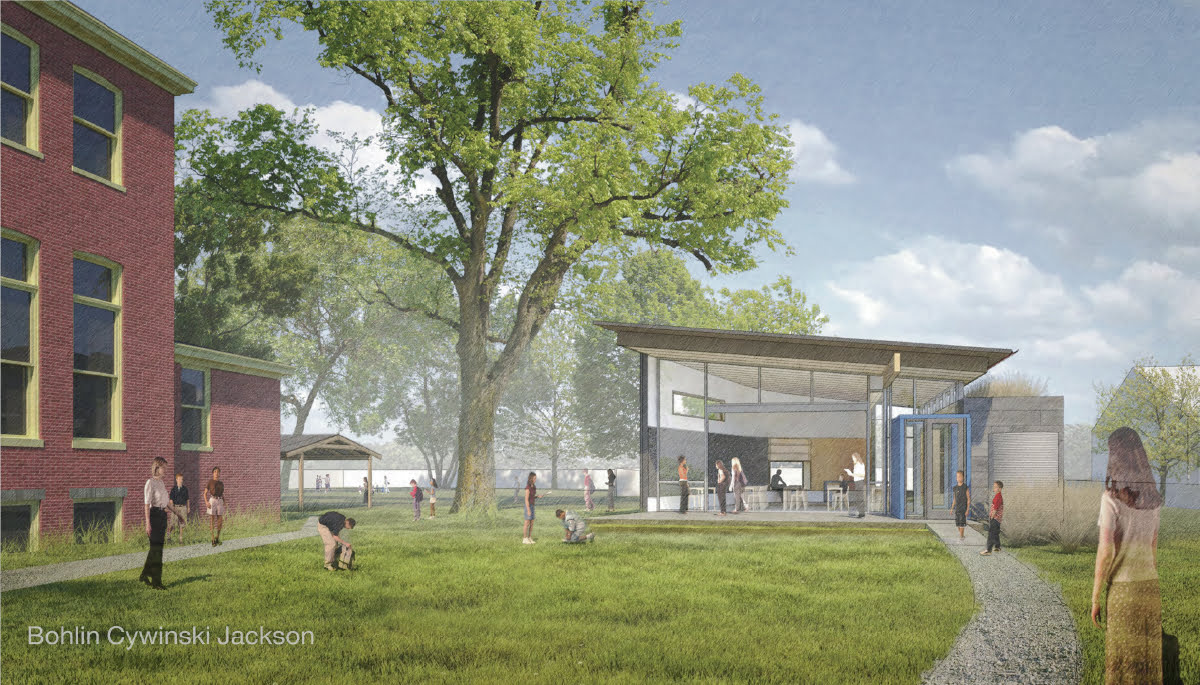Breaking new ground: Waldorf classroom embraces ‘green’ design
Story by Ellen DiBiase, Bulletin contributor
ABOVE: Rendering of the Waldorf School’s new classroom building, looking west towards S. Winebiddle St. Read more in the September 2018 Bulletin. Graphic courtesy of Bohlin Cywinski Jackson.
Friendship – The master plan for the Waldorf School of Pittsburgh’s campus is driven by the maxim that “continued success requires expansion.” Comprised of four phases, the plan involves enhancing the main Victorian-era building at 201 S. Winebiddle St. to accommodate students in grades 1-8.
The plan also calls for improvements to the adjacent yellow building that houses the school’s childcare program, which serves children between the ages of 18 months and 4 years. Finally, the addition of a completely new structure at the rear of the school’s 2.4 acre property would be the final project under Phase 1 of the master plan.
Since 2012, Waldorf has completed six classroom renovations, as well as three grounds-related projects. The new single-classroom building, which is designed to house a class of 25 eighth graders, will help the school provide each grade with its own learning space (based on projected enrollments).
Founded in 1993, the Waldorf School of Pittsburgh began in a small rental property on the South Side – with an enrollment of approximately 90 students in pre-K through fifth grades – before moving to the Bloomfield/Friendship area later that year. Waldorf now supports just over 240 students each school year; its first eighth grade class graduated in 2014.
As the school expands, administrators are focused on aligning its physical growth with ideals of sustainability and place-based learning. Initially, their hope was to build a SEED (Sustainable Education Every Day) classroom for the eighth graders. Yet, after considerable deliberation, school officials decided that this type of modular classroom would not increase the value of the property and did not allow for enough aesthetic choices in the building’s design.
The architectural firm Bohlin Cywinski Jackson (BCJ) was hired to design a new 1,000 square-foot space that not only adhered to sustainable building practices, but also harmonized with the main building’s architectural character. In concert with the natural green spaces on campus, the materials’ palette of the new building is muted and natural; an arced wall embraces outdoor green space that doubles as an amphitheatre for large school events.
According to Kirsten Christopherson-Clark, the Head of School at Waldorf, the project will break ground next year – early enough to get the classroom ready for 2019-2020 school year.
City Council approved the school’s Conditional Use application at a July hearing. In anticipation of the hearing, school officials hosted a public community meeting in May. Christopherson-Clark said she that most of the issues raised by the neighbors in attendance were inquiries about the structural details, energy systems, and how the community would be invited to share in additional uses of the building.
BCJ is pursuing both a Living Building Challenge Petal certification and a WELL Building Standard with the new classroom’s construction. Living buildings give more than they take, creating a positive impact when interfacing with the human and natural systems around them. Waldorf would be the first school in Pittsburgh to achieve this recognition.



Leave A Comment